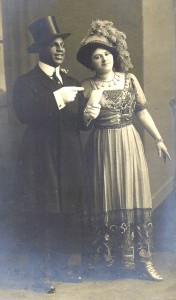 From guest contributor Rainer Lotz*
From guest contributor Rainer Lotz*
Hundreds of African Americans worked as entertainers in Britain, often travelling in continental Europe. Advertisements, reviews, photographs and theatrical memoirs can reveal their activities, and from the 1890s films capture their acts and gramophone records preserve their singing and playing. The career of Josephine Baker is known in outline to many; fewer are aware of Bert Williams, star in the 1900s. Pete Hampton is known to specialist historians for when he died in New York from stomach cancer in 1916 after twelve years in Europe his American reputation had not developed. Hampton made dozens of recordings in London, and a century later copies can be found despite the discs and cylinders being fragile.
George ‘Pete’ Hampton was born in Bowling Green, Kentucky in August 1871. He worked as a banjo player and comedian, and joined the troupe of Bert Williams and participated in In Dahomey which came to England in May 1903. The eighty singers and dancers caught the mood of theatrical London and In Dahomey continued to play to full houses until the end of 1903 when it toured to Scotland for some months. Hampton made cylinder recordings for Edison Bell and, in January 1904, discs for the Gramophone and Typewriter Company and Odeon, then Nicole. The labels generally described him as a ‘Negro Comic’, the repertoire was often from In Dahomey, and the titles used – as was the fashion – ‘Coon’. The composers were usually African Americans. ‘Plantation melodies’ such as ‘Massa’s in the Cold Cold Ground’, ‘Swanee River (Old Folks at Home)’, ‘My Old Kentucky Home’ and ‘Oh! Dem Golden Slippers’ were presented and recorded, as were more ephemeral songs with titles that we now find uncomfortable – ‘Coonville’s Cullud Band’, ‘Dat Mouth Organ Coon’, and ‘A Darkey Camp Meeting’. Hampton’s baritone and falsetto, and his harmonica (mouth organ) playing are captured on the numerous recordings.
From photographs and reviews we know Hampton played the banjo. Hampton, his future wife Laura Bowman, Fred Douglass and Will Garland formed a quartet, the Darktown Entertainers and were in Bradford in March 1905 before moving on to Germany, Hungary and Poland. They returned to London after a year and toured on the Stoll-Moss circuit, Hampton recording for Neophone. Hampton recorded for other enterprises, and with Bowman, and also in the Darktown Entertainers. That group toured to Germany into 1907. Bowman and Hampton shown above were ‘colored Character Duettists’ and they were in Switzerland and Italy, followed by another tour of Britain in 1908 when audiences in Oldham, Barnsley and Lincoln saw them. She appeared at the London Hippodrome, a prestigious venue, in mid-1908.
The pair briefly visited the U.S.A. in May 1910, returning to tour on the Barrasford chain of variety theatres, appearing in Wolverhampton, Keighley, Liverpool and Southampton, then Aberdeen. Vienna saw them in early 1911, returning to the British provinces including Morecambe. Bowman’s parents settled in London by 1910, sharing with their daughter, Hampton and a Russian servant at 14 Marlborough Road near Wimbledon Park which they named Darktown Villa.
When playing in Budapest in August 1912 a reviewer said Hampton was ‘a harmonica virtuoso’. The evidence of Hampton’s playing on ‘Mouth Organ Coon’ (Edison Bell cylinder and Nicole’s disc also of June 1904) is virtuosic. We have almost no contemporary recorded evidence to compare to it for harmonica players who had recorded by 1904 were very few – and they were Scandinavian. Elements in Hampton’s performances suggest traditions in African American music, known through American recordings from the 1930s, had old roots. With the then-amusing Coon Song lyrics, the skilled banjo-playing, and the quartet performances of the Darktown Entertainers, we can see why Hampton’s career as an entertainer in Britain and the continent lasted for years.
The sounds that Hampton’s recordings have preserved are an easy-to-overlook aspect of African American achievement. We have been blinkered by the assumption that African Americans recorded only in the U.S.A. and that there they were restricted by social and economic segregation which kept them out of the recording studios until the 1920s. What the British – and audiences in Italy, Saxony, Berlin and the Ukraine, etc – thought of Hampton remains unknown, but his regular employment on major theatrical circuits suggests he was a popular entertainer, a century ago.
–oOo–
Bear Family Productions issued 24 of Hampton’s recordings including ‘Dat Mouth-Organ Coon’ on CD 1 in the three CD set Over There! Ref BCD 16020 CP
* Rainer Lotz lives in Bonn, Germany. He has written numerous articles on the early recording industry including Grammophonplatten aus der Ragtime-Ara (1979), and German Ragtime and Prehistory of Jazz (1985). His research on black entertainers in Europe has been published widely, some collected in Black People: Entertainers of African Descent in Europe, and Germany (1997) and others in specialist journals such as ‘The Florida Creole Girls’ in The Rag-Time Ephemeralist No 3 (2002).
LEAVE ANY RESPONSE IN THE BOX AT THE FOOT OF THE PAGE.

Hello Jeffrey! Ive been reading your essays on Black Edwardian England. My interest is in eblack entertainers in England between 1895, when my great grandfather stowed away to Glasgow from Guyana and the 1930s. The whole family, my grandmother and her siblings were in Circus Schumann in 1906-1907 and then in the West End and various venues performing in minstrel shows, circuses, and pantomimes.I would like to send you a picture of William and Rose Garland, my grandmother had as she said she had been employed by them as had her father Joseph Gibson. I also have pictures of them in various productions including Chu Chin Chow.
What is the source of your photograph? I would like to use it in a book.
This image is from my personal collection of photographs and postcards